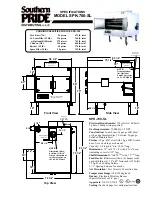
5
2
INSTALLATION
ATTENTION!
Detector components should be taken only beyond the side surfaces
of their bodies, avoiding touching the outer optical elements (filters).
A protective film with optical elements to remove the least
immediately before latching
operation
threshold
on site.
2.1 The appearance and dimensions of the receiver and the transmitter are
shown in Appendix A.
2.2 Installation of transmitters and receivers should perform on fixed
structures and components of buildings on one optical axis towards each other.
The mounting surface for the detector’s components must be firm and
vibration-free. Metal supports that may be affected by heat or cold are unsuitable
for the installation.
Fastening base receiver and transmitter to the surface and perform two
fasteners (bolts, screws, dowels, not supplied) in accordance with Appendix B.
Pass the wires through the cable glands of the base (see Appendix A) and
connect them to the screw terminals of the connectors from the detector set.
Tighten the nut of the clamp of the seal only after passing all the wires.
It is possible to insert the wires from behind, for which it is allowed to drill the
holes of the correct size at the base of the detector components.
The side of the detector's receiver, on which the LED and the IR receiver of
the remote control is located, is deployed in the direction from which the LED and
the IR receiver of the detector's remote control are visible to the service personnel
(it is recommended to point downwards).
The side of the detector's transmitter, on which the LED is located, should be
deployed in the direction from which the LED of the transmitter is visible to the
service personnel (it is recommended to point downwards).
After installation, provide for measures to isolate the places of entry of wires
to protect against moisture, dust, penetration of insects.
2.3 Installation angle should comply with the maximum tolerances in any
planes relative to the optical axis of transmitter and receiver.






































